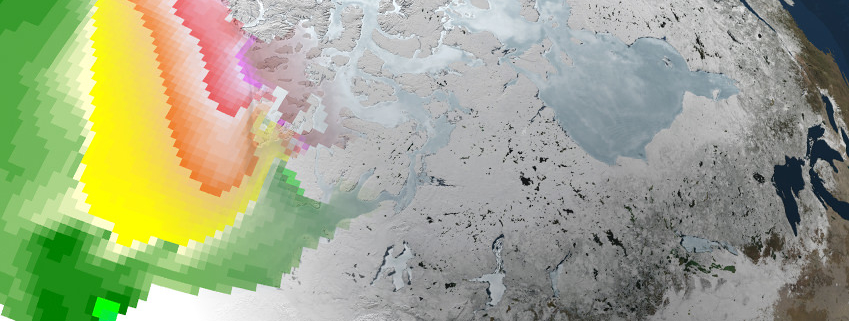
Arctic sea ice has been declining at dramatic rates while Antarctic sea ice has slightly expanded over the past decades. BSC-ES scientists attempt to reconcile these contrasting trends with state-of-the art climate models and advanced statistical techniques.
Summary
Sea ice forms when seawater temperature drops below its freezing point. Unlike glaciers or ice sheets, it does not contribute to sea-level rise when melting, but still is an important player in the global climate system. It hinders transfers of mass, energy and momentum between the two "giants" of our climate, the atmosphere and the ocean. The thin layer of sea ice (a few meters at most) is at the center of many physical feedbacks, and has to be accounted for in our understanding of past and future climate variability from sub-seasonal to centennial timescales.
Sea ice found in two places on Earth. In the Arctic (an ocean surrounded by continents), sea ice responds mostly to thermodynamic changes. Over the past decades, September sea ice extent has receded by as much as 50%, loosing every year the equivalent of three times the surface of Catalunya! Several indicators also point to dramatic reductions in the thickness of ice, but are less accurate due to the inherent difficulty to estimate this parameter from space. In the Antarctic (an ocean surrounding a continent), the story is quite different. Sea ice extent there is mostly controlled by dynamic changes associated to wind regimes (especially in austral winter), and not much information is available from its thickness: the Southern Ocean is simply too remote and too vast to allow for well-sampled monitoring of the ice. The few records available indicate an overall increase in sea ice extent since the late 1970s, but with highly contrasted spatial patterns.
How can we, in the same global warming context, explain these past changes and how can we predict future ones, while informing stakeholders that need this information most? This is the objective of the Sea Ice Variability, Prediction and Impacts Research Line at the BSC Earth Sciences department. Its members work at better characterising the modes of sea ice variability, assessing the role of high-latitude sea ice changes on lower-latitude regions (Eurasia, U.S., South America, Australia), attributing individual events like the 2012 all-time record in Arctic sea ice extent, or improving dynamical prediction systems. Researchers collaborate actively with international partners (from all over Europe, U.S., China) and are anchored in major international programs such as the Sea Ice Prediction Network, the Year of Polar Prediction, the Climate and Cryosphere (CliC) and Climate Variability and Predictability (CLIVAR) panels of the World Climate Research Programme of the World Meteorological Organization.
The researchers are located at Room 1D of the Nexus II building and will be more than happy to discuss more about this fascinating topic to anyone interested.
Objectives
The objectives of the Sea Ice Variability, Prediction and Impacts Research Line are:
- The generation of realistic sea ice reconstructions for a better understanding of past sea ice variability, using advanced data assimilation techniques
- The improvement of sea ice initialization for global climate forecasts from timescales of the season to the decade and beyond,
- The development of advanced statistical techniques, inspired from machine learning, to extract preferred modes of sea ice variability,
- The assessment of high- to mid-latitude linkages in the climate system,
- The use of multiple observational products (and their uncertainties) to account for observational errors in the course of model evaluation
- The assessment of high-resolution for global sea ice modelling
